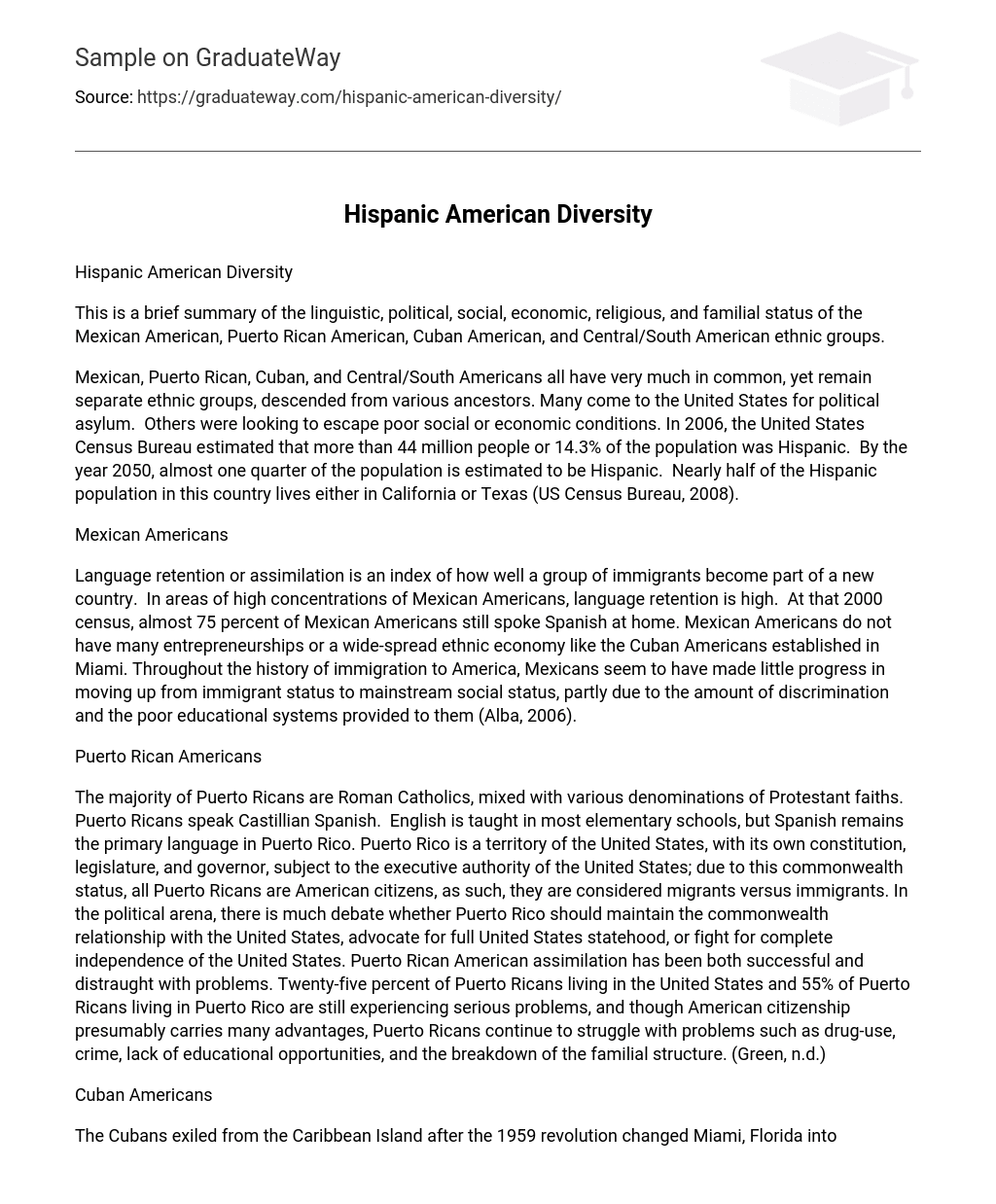This is a brief summary of the linguistic, political, social, economic, religious, and familial status of the Mexican American, Puerto Rican American, Cuban American, and Central/South American ethnic groups.
Mexican, Puerto Rican, Cuban, and Central/South Americans all have very much in common, yet remain separate ethnic groups, descended from various ancestors. Many come to the United States for political asylum. Others were looking to escape poor social or economic conditions. In 2006, the United States Census Bureau estimated that more than 44 million people or 14.3% of the population was Hispanic. By the year 2050, almost one quarter of the population is estimated to be Hispanic. Nearly half of the Hispanic population in this country lives either in California or Texas (US Census Bureau, 2008).
Mexican Americans
Language retention or assimilation is an index of how well a group of immigrants become part of a new country. In areas of high concentrations of Mexican Americans, language retention is high. At that 2000 census, almost 75 percent of Mexican Americans still spoke Spanish at home. Mexican Americans do not have many entrepreneurships or a wide-spread ethnic economy like the Cuban Americans established in Miami. Throughout the history of immigration to America, Mexicans seem to have made little progress in moving up from immigrant status to mainstream social status, partly due to the amount of discrimination and the poor educational systems provided to them (Alba, 2006).
Puerto Rican Americans
The majority of Puerto Ricans are Roman Catholics, mixed with various denominations of Protestant faiths. Puerto Ricans speak Castillian Spanish. English is taught in most elementary schools, but Spanish remains the primary language in Puerto Rico. Puerto Rico is a territory of the United States, with its own constitution, legislature, and governor, subject to the executive authority of the United States; due to this commonwealth status, all Puerto Ricans are American citizens, as such, they are considered migrants versus immigrants. In the political arena, there is much debate whether Puerto Rico should maintain the commonwealth relationship with the United States, advocate for full United States statehood, or fight for complete independence of the United States. Puerto Rican American assimilation has been both successful and distraught with problems. Twenty-five percent of Puerto Ricans living in the United States and 55% of Puerto Ricans living in Puerto Rico are still experiencing serious problems, and though American citizenship presumably carries many advantages, Puerto Ricans continue to struggle with problems such as drug-use, crime, lack of educational opportunities, and the breakdown of the familial structure. (Green, n.d.)
Cuban Americans
The Cubans exiled from the Caribbean Island after the 1959 revolution changed Miami, Florida into what many have deemed the capital of Latin America. During the Cold War many political refugees sought asylum in the United States where they happily accepted the benefits offered here. The Cuban Americans significantly changed many things in Miami, including reversing the typical progression of assuming American culture and societal assimilation. Instead of replacing Spanish with English and assimilating American cultures, they brought about what has been termed “reverse acculturation”, meaning Miami residents had to become accustomed to the Cuban economical impact and political domination. However, unlike the Cuban immigrants, Haitian immigrants, derogatively referred to as “the boat people,” faced insurmountable racism and alienation for their entry into the United States. Haitian immigrants changed the typical assimilation by concealing their heritage and adapting the dress and attitudes of the African American inner city youths. (Cato, n.d.)
Central/South Americans
Within the United States, different ethic groups tend to gravitate toward various geographic centers. Central Americans tend to migrate toward the western United States with the Mexican Americans, while South Americans tend to live on the eastern United States with Puerto Ricans and Cuban Americans. Cuban Americans and South and Central Americans have the highest college graduation rates of Hispanic American groups at 19 and 16%, respectively. As expected, this results in the lowest poverty rates among Hispanic Americans.
Mexican Americans, Puerto Rican Americans, Cuban Americans, and Dominican Americans each have a distinct cultural identity–rich in familial ties, but each has been grouped in the Hispanic American category on the basis of language. Though these groups share the Spanish language, each has a different dialect and origin. Although Roman Catholicism is the primary religion of each group, there also exists in each ethnic group a variety of religious beliefs. While each group values familial connections, several groups show a change in family dynamics upon immigrating to the mainland United States. Cuban American seems to have made the most progress on the social and political front, while Puerto Ricans have made the most impact on their homeland in the economic realm. While some groups resist assimilation into American culture, others have readily embraced it.
References
Alba, R. (2006). Mexican Americans and the American dream. Political Science &
Politics. American Political Science Association. Retrieved April 10, 2009from
http://www.apsanet.org/imgtest/PerspectivesJun06Alba.pdf
Buffington, S. (n.d.). Dominican Americans. Retrieved April 10, 2009from
http://www.everyculture.com/multi/Bu-Dr/Dominican-Americans.html
Cato, J. (n.d.) Becoming American in Miami: Reconsidering immigration, race and ethnic
relations. Center for Latin American Studies, University of California, Berkeley. http://socrates.berkeley.edu:7001/Events/fall2003/11-20-03-stepick/index.html
Green, D. (n.d.) Puerto Rican Americans. Retrieved April 10, 2009from
http://www.everyculture.com/multi/Pa-Sp/Puerto-Rican-Americans.html
United States Census Bureau. 2000 Census Data. Retrieved April 10, 2009
from http://www.census.gov/ .





